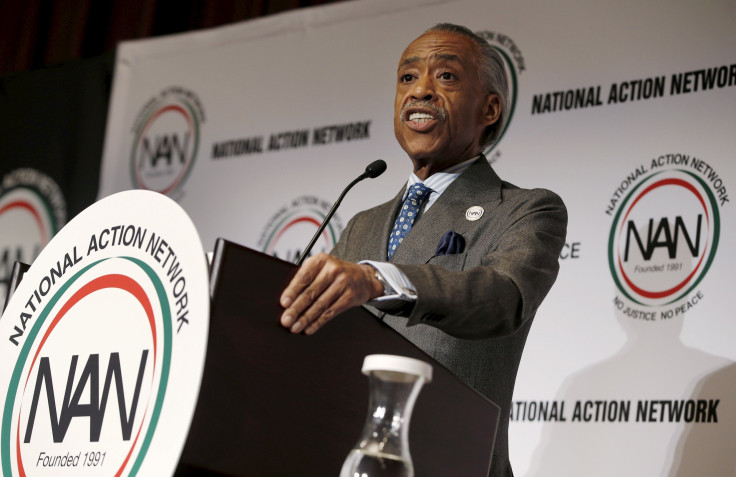Journalists Grade Race-Based Media Coverage: Walter Scott, Michael Brown Discussed At Al Sharpton's Civil Rights Convention

It’s been five months since the civil unrest in Ferguson, Missouri, drew hordes of journalists and TV crews to a small Midwest community that literally burned with rage during protests over the death of an unarmed black man. But in the ensuing news coverage, the performance of media outlets was up for debate Friday at the Rev. Al Sharpton’s National Action Network convention in New York City, during a panel discussion of how race is tackled by the media.
Panelists who work in mainstream and ethnic media agreed the coverage surrounding Michael Brown's death last summer should have a lasting, teachable impact for how police shootings and race are written and talked about in an increasingly democratized media landscape. New and racially diverse voices that emerged during several months of coverage helped media outlets learn lessons about avoiding stereotypical portrayals of African-American shooting victims, for which they would be held accountable for failing at being fair in race-based coverage, some panelists said.
“In a very profound way, Michael Brown and Eric Garner force the media to change the way that we cover the shootings of black men by police,” said Joy Reid, a national correspondent for MSNBC. “There was a point in the coverage when part of the media were trying to spin the entire Ferguson story into one of out-of-control black people rioting.”
Biased Narrative Stuck
Reid said that while reporting on the case of Walter Scott -- a black unarmed Coast Guard veteran killed by a police officer in North Charleston, South Carolina, last weekend -- she realized that particular biased Ferguson narrative stuck with some journalists and audiences. “One of the reporters said, ‘Are you surprised that this didn’t become another Ferguson? … [He was] implying that the natural inclination of the African-Americans community is to just go out and burn the community down.”
Along with Reid, editors from the black lifestyle magazines Ebony and Essence agreed that the media had not been careful enough in characterizing the scope of protests happening in Ferguson. In general, said Jamilah Lemieux, a senior editor at Ebony, stories in which race factors in how the public perceives black victims of crime continue to be a struggle for many outlets. Specifically, she said, there is too little discussion in news organizations about which images should be broadcast in police-involved shootings of African-American men.
“When it comes to [black victims], there is the ‘are we going to present him as a good kid or bad kid? If he’s smiling, are we suggesting that he’s good? Is it our job to say whether he’s good or bad?’” Lemieux said. For example, she said, mainstream organizations seemed more comfortable with showing negative instead of neutral images of Brown and Trayvon Martin, the unarmed Florida teenager killed in 2012 by neighborhood watch volunteer George Zimmerman.
Recent reports about television coverage support the suggestion that news portrayals of racial and religious minorities are skewed from reality. A recent study of TV news broadcasts by University of Illinois professor Travis Dixon found that African-Americans are underrepresented in media reports as both victims and perpetrators of crime. On the other hand, Muslims were overrepresented in reports as terrorists and Latinos as criminal immigrants, Dixon’s study found. A separate analysis by Media Matters found broadcast news stations in New York City provided disproportionate coverage to crime stories involving African-American suspects. The news stations covered cases of murder, theft and assault at a higher rate than blacks who were arrested for those crimes in New York.
Social Media Helps
The convention's panelists also agreed social media has helped activists and victims’ families raise awareness about the unfair portrayals when mainstream media was slow to pick it up. “If there was something that was being misrepresented by the media, people went on Twitter and Black Twitter went crazy to check it,” said Vanessa DeLuca, editor-in-chief of Essence. “That’s a huge win because the voices of the people were heard and came through the strongest” during the Brown shooting demonstrations.
Media coverage is often built around who is available to speak on behalf of a victim's family or the community, said Ken Sunshine, president of the public relations firm Sunshine Sachs, which consults in part with Sharpton. Sunshine said those families and community leaders should choose their spokespeople carefully and seek advice from professionals such as publicists if they are concerned about potential unfair media portrayals.
However, there could never be a so-called perfect victim or spokesperson, panelists said, using Martin Luther King Jr. as an example of someone who was not always popular across the board. Still, King's effective messages helped to drive civil rights progress and counter racial stereotypes in the media, Reid said.
“If you’re popular as a civil rights leader, then something just ain’t right,” she told the audience of activists. “So don’t be discouraged when civil rights organizations are attacked and don’t run away from your civil rights institutions. You can’t do this alone.”
© Copyright IBTimes 2025. All rights reserved.




















